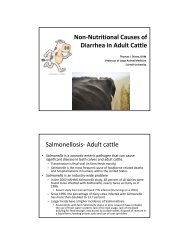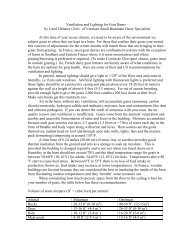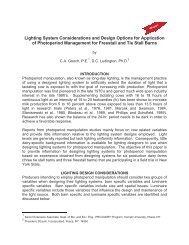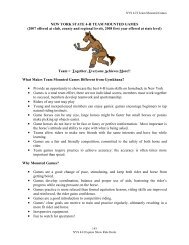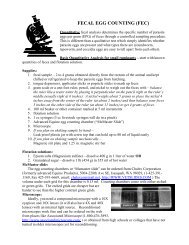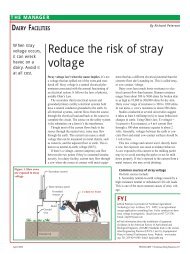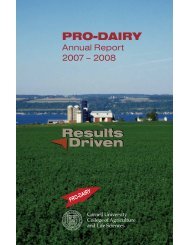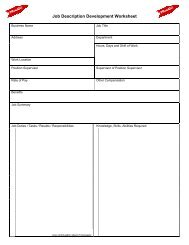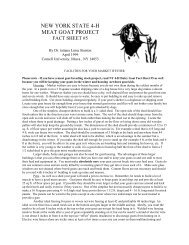SUSTAINABILITY AND DAIRY PRODUCTION: CHALLENGES AND ...
SUSTAINABILITY AND DAIRY PRODUCTION: CHALLENGES AND ...
SUSTAINABILITY AND DAIRY PRODUCTION: CHALLENGES AND ...
You also want an ePaper? Increase the reach of your titles
YUMPU automatically turns print PDFs into web optimized ePapers that Google loves.
<strong>SUSTAINABILITY</strong> <strong>AND</strong> <strong>DAIRY</strong> <strong>PRODUCTION</strong>: <strong>CHALLENGES</strong> <strong>AND</strong>OPPORTUNITIES 1D.E. Bauman 1 and J.L. Capper 21 Department of Animal Science, Cornell University2 Department of Animal Sciences, Washington State UniversityINTRODUCTIONThe productivity of the American farmer has increased dramatically over the last onehundred years. At the start of the 20th century a farmer produced enough food to feedless than 15 people and over 40% of the U.S. population was involved in agriculturerelatedbusinesses. By the 1940’s farms were still diversified and productivity hadincreased to where a farmer produced sufficient food to feed about 20 people. Todaythe food produced by an average farmer feeds 155 people and farmers represent lessthan 2% of the U.S. population. Over the last 6 decades, the yield of grain crops andproductivity of domestic animal species has more than doubled. As a consequence U.S.agriculture produces nearly one-fifth of the world’s milk, eggs, and grain and about onefourthof the world’s beef. Increases in agricultural productivity over the last centurymean that when compared to other global regions, American consumers also spend thelowest percent of their annual income on food - around 10%. This provides theopportunity for our population to pursue the wide range of lifestyles that we enjoy today.Sustainability has historically been considered to be an economic issue; asustainable system was one that produced food at a price that consumers could affordwhile providing sufficient income for the producer. More recently sustainable productionhas taken on a broader context and represents a system that balances economicviability, environmental impact and social acceptability. Thus, a sustainable agriculturesystem includes an economic dimension represented by an industry that is productive,efficient and profitable; an environmental dimension characterized by an industry thatmakes the most effective use of resources, maintains air and water quality andpreserves wildlife habitat and rural landscape; and a social dimension demonstrated byan industry that cares for and takes into consideration the community, employees andanimal welfare. In short, a sustainable agricultural system is one that provides for basichuman food and fiber needs, is economically viable and enhances the quality of life ofproducers and society as a whole while preserving the resource base andenvironmental quality on which the future of agriculture depends.The IFPRI (1995) has eloquently articulated the global vision for a sustainableagriculture system as follows:1 Portions of this paper are from an article by Bauman and Capper (2011) and Capper (2011).
The objective of our presentation is a broad consideration of several key issuesrelated to sustainability of animal agriculture, particularly the dairy industry. We havefocused on the challenges and opportunities in three areas – productive efficiency,environmental issues and dairy products as foods.THE IMPORTANCE OF PRODUCTIVE EFFICIENCYIn 1944, the U.S. dairy herd peaked at 26.5 million cows; the typical dairy farm wasdiversified with a herd size of about 6 cows and an average daily milk production of lessthan 7 kg/cow (Capper et al., 2009a). This contrasts sharply with the specialization ofthe modern dairy industry where cows have an average milk production over 30 kg/dand about 60% of the U.S. milk supply comes from dairy farms with over 500 cows(USDA, 2007). These impressive gains in daily milk production per cow over the last 6decades reflect a better understanding of the biology of the dairy cow and theapplication of this knowledge to improve genetic techniques to select the mostproductive cows and the application of management practices and new technologies tosupport a high level of milk production. Genetic gains are estimated to represent abouttwo-thirds of the improvement in milk yield per cow over the last 6 decades. Theimplementation of artificial insemination (AI) and genetic selection programs has beencomplimented by advances in feed analysis and diet formulation; improvements inmilking systems; developments in cow comfort and facility design; and progress indisease treatment and the implementation of herd health programs. Thus, the dairyindustry has utilized AI and genetic selection to increase the milk production potential ofdairy cows and at the same time implemented management practices and technologieswhich provide an opportunity for cows to achieve their genetic potential.So what is the biological basis for the high milk yield in genetically superior cows?Differences in nutrient partitioning provide the major biological basis for milk yielddifferences between high and low-yielding dairy cows. High-yielding dairy cows partitiona greater portion of nutrient intake to support a higher milk yield and this isaccompanied by an increased voluntary feed intake (Bauman et al., 1985; Reynolds,2004). If a low-producing cow has a high nutrient intake she simply partitions the extranutrients to body fat rather than to produce milk and milk components.The increase in milk yield per cow is important to the dairy industry because it affects“productive efficiency”. We define productive efficiency as “milk output per unit ofresource input”, and the advantage from improved productive efficiency relates to whatis referred to as the “dilution of maintenance” effect (Bauman et al., 1985; VandeHaarand St-Pierre, 2006). Each day, the lactating dairy cow requires nutrients formaintenance and for milk synthesis. The maintenance requirement does not changewith production level and can, therefore, be thought of as a fixed cost needed tomaintain vital functions. Assuming milk composition remains constant, the nutrientrequirement per unit of milk does not change, but the total energy cost for lactationincreases as a function of milk yield. The lactation energy requirement can, therefore,be considered a “variable cost” of dairy production. This is illustrated in Figure 2 wherethe ME requirements of an average cow for 1944 and 2007 are compared (Capper et
al., 2009a). In 2007, the average performance of a dairy cow resulted in a daily MErequirement over twice that of the average cow in 1944. This was mainly due to a highermilk production, although maintenance was marginally greater in 2007 because of theindustry shift to a higher proportion of large-breed cows. The key comparison is thedifference in nutrient use; in 1944 the average cow utilized 65% of ME intake formaintenance and only 35% for milk synthesis. These numbers are essentially reversedin 2007 where the average cow utilized only 33% of the ME requirement formaintenance and 67% of ME for the production of milk. As milk production increases,the total nutrient requirement also increases but productive efficiency is improvedbecause the fixed cost (maintenance) is diluted out over more units of milk production.The net result is the energy requirement per unit of milk output is reduced and a unit ofmilk can be produced using fewer nutrients with less animal waste (Bauman et al.,1985; Capper et al., 2009a).Productive efficiency gains for today’s dairy industry notwithstanding, someconsumers perceive that historical methods of food production are moreenvironmentally friendly and better for cow welfare and well-being. This perception isfrequently reinforced by an idyllic vision of the “good ole days” where cows grazedpeacefully on a lush green hillside with the red hip-roof barn off in the distance. Moderndairy farms are often referred to as “factory farms” where it is claimed that cows aremaintained in “filthy and disease ridden conditions” 2 , and the milk they produce is“awash in fat, cholesterol, antibiotics, bacteria and pus” 3 . These claims, which show adisappointing ignorance of the dairy industry on many levels, are oft-repeated,especially by animal rights groups, and they are reinforced by videos and mediaaccounts of animal abuse that are presented as typical of modern animal agriculture.Participants at the Cornell Nutrition Conference are well aware of managementpractices on commercial dairy farms, but we need to remind the public that dairymanagers take pride in their operation. We need to emphasize that economic viabilityand welfare of the dairy herd are irrevocably connected and modern dairy producersstrive to follow best management practices that benefit the productivity and welfare oftheir herd. Diets are balanced according to the latest computer-based ration formulationprograms to meet the cow’s nutrients requirements and they are fed as total mixedrations to maximize nutrient use and minimize losses. Commercial dairy operationshouse cows in a facility where temperature and ventilation are controlled andcontinuous access to water, feed and a dry bedded area is provided. The milkingoperation uses best practices for proper udder sanitation, milk let-down and milkremoval. Modern dairies follow a rigorous herd health program throughout the life cycleof the dairy animals and if a calf or cow becomes ill they are treated by the herdveterinarian following the latest procedures and using efficacious treatments.2 Nierenberg, D. (Animal Agriculture and Climate Change Specialist, Humane Society of the United States).Comment at the Hudson Institutes Conference on Food for the 21 st Century: Challenging theConventional Wisdom, Washington DC, September 10, 2008.3 Heimlick, J. (author of many health and nutrition books). Comment from Heimlicks’ Forward in the bookMilk the Deadly Poison by R. Cohen, Argus Publishing, Inc., 1997.
Figure 2:Illustration of the “dilution of maintenance” effect. Bars for metabolizableenergy (ME) requirement depict the portion of maintenance (dark and theportion for milk synthesis (shaded). Bars for % maintenance requirementsfor an average cow in the 1944 and 2077 dairy production systems.Adapted from Capper et al. (2009a).Nevertheless, some scientists question whether high milk production and improvedproductive efficiency are contrary to the health and well-being of dairy cows (Rauw etal., 1998; Broom, 2001; Knaus, 2009). For example, Broom (2001) suggested that itmay be necessary to stop “using genetic selection and some feeding methods thatincrease milk yield” because cows become stressed and “their normal biologicalcontrols are overtaxed”. Does the science support claims that cows on modern largefarms are stressed and of poor health, and that high production and increases inproductive efficiency are pushing cows too far?Over the last 60 years gains in knowledge relating to the regulation of nutrientpartitioning have provided an understanding of how essential biological processes arecoordinated to maintain well-being in lactating dairy cows (Bauman and Currie, 1980;Bauman, 2000; Collier et al., 2005). This coordination operates on an acute basis(homeostatic regulation) to ensure constant conditions are maintained, and on a longertermbasis (homeorhetic regulation) to ensure adequate nutrient partitioning to supportessential physiological functions and mammary synthesis of milk. The claims that highproducing dairy cows are stressed and their welfare is compromised have been raisedat regular intervals over the last half century. In each instance, scientists have found nosupport for these claims and concluded that they are based on a failure to understand
the biology of lactation (for examples, see Hammond, 1952; Bauman et al., 1985;Reynolds, 2004; Collier et al., 2005). Dairy herd managers, veterinarians and dairyconsultants know that the performance of a dairy cow provides an irrefutable indicationof her health and well-being. High-producing cows are not stressed and sick becausethey have an increased milk output; rather they achieve high milk production becausethey are healthy and have minimal stress. A clear example of this is provided byexamining somatic cell counts (SCC). SCC is associated with mastitis and thus itrepresents an important milk measure that reflects mammary health, milkingmanagement and milk quality. When the major factors causing mastitis are accountedfor, there remains a positive genotypic and phenotypic correlation between mastitisincidence (cases per cow) and milk yield (Wilton et al., 1972). Nevertheless the effect isvery small, and mastitis is primarily associated with the quality of management andenvironmental factors. The importance of quality of management is evident by the factthat on a herd basis, the average milk SCC declines as average milk yield per cowincreases (Figure 3), providing a clear refutation of the previously discussed perceptionsthat the health and welfare of high producing cows are compromised. It bears repeatingthat modern dairy cows achieve a high milk production because they are healthy andhave minimal stress.There must be an upper limit where the biological controls regulating nutrientutilization for milk synthesis are maximized, but that maximum plateau is not obvious.Today, top herds have an annual production average over 14,000 kg/cow with recordcows producing over 30,000 kg. It is interesting to note the dilution of maintenanceeffect in these cows: in herds with an annual milk average of 14,000 kg, cows areutilizing about 75% of their ME requirement for the synthesis of milk, and for the currentworld record cow the value approaches 85%. Performance is the best indicator of adairy cow’s well-being and we know from the records set by top cows that the biologicalcontrol systems will allow for increases in milk yield to at least these current recordlevels.ENVIRONMENTAL ISSUES“Green” has become the color of the decade, and surveys indicate thatenvironmental considerations are of increasing importance in consumer choices,including food purchases. All food production has an environmental effect and theenvironmental impact of dairy production is of particular significance. In December2009 USDA and the Innovation Center for U.S. Dairy signed a Memorandum ofUnderstanding to work jointly in support of the goal to reduce the dairy industries greenhousegas (GHG) emissions by 25% over the next decade (Innovation Center for U.S.Dairy, 2010). However, some consumers romanticize older, inefficient productionmethods and perceive that dairy sustainability can best be achieved by extensive, lowinputsystems. It’s an image that has emotional and philosophical appeal, but is itsupported by science?
Figure 3. Comparison of milk somatic cell counts (SCC) and annual milk production percow. Data are for 16,768 herds over the period of November 2009 to October2010, with each point representing all herds at that annual level of milkproduction. From Bauman and Capper (2011) with data compiled and figureconstructed by H.D. Norman and J.R. Wright (USDA-ARS-AIPL).Feed and milk production comprise about 80% of the total environmental impact ofdairy foods in industrialized countries, and an even greater percent in developing worldregions (UN/FAO 2010). We recently used a whole-system model to quantify theenvironmental impact of milk production on U.S. dairy farms circa 1944 as compared to2007 (Capper et al., 2009a). On an individual cow basis, the average 1944 cow hadless than one-half of the daily carbon footprint (CO 2 -equivalents) of modern highproducingdairy cows (Figure 4). This is consistent with the lower nutrient and resourcerequirement of the low-producing 1944 cow (Figure 2), so at first glance this appears tosupport the concept that the “good ole days” were more environmentally friendly.However, the dairy industry exists to produce milk rather than cows. When results areexpressed per unit of milk, the advantages gained from improvements in productiveefficiency on modern dairy farms are striking. The carbon footprint of a unit of milkproduced in 2007 is only 37% of that in 1944 (Figure 4). The reduction in the carbonfootprint of milk production over the last half-century represents a remarkable success
Figure 4. Comparison of the carbon footprint on a per cow basis and on a kg milk basisfor 1944 and 2007 dairy production systems. Adapted from Capper et al.(2009a).story for the environmental impact and sustainability of the U.S. dairy industry. As aconsequence of productive efficiency gains between 1944 and 2007, the production ofan equal quantity of milk in 2007 requires only 21% of the animals, 23% as much feed,35% of the water, 10% of the land area and produces only 24% as much animal waste(Capper et al., 2009a). Particularly impressive is a comparison of the total dairyindustry. In spite of reductions in cow numbers (9 million in 2007 vs. 25.6 million in1944), the 2007 dairy industry produced 59% more milk with a total carbon footprint thatwas 41% less than the 1944 industry (Capper et al., 2009a).If we examine international trends, increased milk production has a mitigating effectupon carbon emissions on a global basis. The environmental effects of regionalvariations in productivity are exemplified by the results of a recent UN/FAO (2010)report that modeled GHG emissions from dairy production using life cycle analysis(LCA). As intensity of production declines and the average milk yield shifts fromapproximately 9,000 kg/cow for North America to ~250 kg/cow for Sub-Saharan Africa,the carbon footprint increases from 1.3 kg CO 2 -eq/kg milk to 7.6 kg CO 2 -eq/kg milk
(Figure 5). However, assessing dairy system sustainability should not be limited to theenvironmental impact of dairying within a specific region, but must also considereconomic and social implications. While the UN/FAO data could provoke the conclusionthat all regions should adopt North American and Western European-style productionsystems, or that dairying should be focused in these areas and be discouraged in lessproductive regions such as Sub-Saharan Africa and South Asia, the significant social(both status and nutritional) and economic value of dairying in less-developed regionsmust not be underestimated. The challenge for global dairy production is to optimizesustainability within each region rather than prescribing the best “one-size-fits-all” globalsystem.The variation in carbon footprint among regions of the world reflects a wide range ofsystem efficiencies. The efficiency of production systems also differs amongindustrialized regions. Figure 6 shows trends in milk production per cow from 1960 to2007 for the U.S., Canada, an aggregate of the top-6 milk producing countries inEurope (Netherlands, UK, Germany, France, Italy, Poland), and New Zealand.Although milk yields were similar among regions in 1960, the lines have divergedmarkedly over time. The U.S. has shown the fastest rate of improvement, Canada andEurope are intermediate and New Zealand production has remained relatively static.Thus, in 2007 the average U.S. dairy cow produced over 9,100 kg milk per year inhighly efficient U.S. dairy production systems as compared to annual production valuesof about 8,400 kg/cow for Canada, 6,400 kg/cow for the top 6 milk-producing counties inEurope, and 3,800 kg/cow for New Zealand (UN/FAO 2010). As discussed earlier,improvements in productivity for the U.S., Canada and Europe were made possible byadvances in genetics, nutrition, management and animal health. An example of theeffect of technology on environmental impact is the adoption of recombinant bovinesomatotropin, which reduces GHG emissions per unit of milk by ~9% (Capper et al.,2008). Differences in the rate of improvement may, therefore, be partially explained bythe attitude towards and the adoption of technology and innovative managementpractices within various regions. The U.S. is generally pro-technology whereas Europeis less receptive (Moses, 1999; Wilcock et al., 2004). The New Zealand dairy system anumber of similarities to many U.S. organic dairy systems, and it represents somespecial challenges. First, it is a pasture-based system with an average lactation lengthof only 252 days. Second, the daily maintenance requirement is greater due to grazingactivity, and milk production is lower due to an inadequate supply and balance of dietarynutrients (Kolver, 2003). Regardless of system specifics, higher productivity of milk withequal composition reduces the environmental impact of dairy production because feweranimals are required to produce the same amount of milk. On a herd basis, producingthe same amount of milk with fewer resources (or more milk from the same quantity ofresources) reduces the demand for non-renewable or energy-intensive inputs (e.g. land,water, fossil fuels and fertilizers) and promotes environmental stewardship.
Figure 5. Average annual milk yield and carbon footprint per kilogram of milk forselected global regions (Capper 2011). Based on data from UN/FAO (2010).<strong>DAIRY</strong> PRODUCTS AS FOODSHealth and wellness are of foremost importance to consumers and diet plays acritical role in health maintenance and the prevention of disease. The value of dairyproducts and other animal source foods in meeting the food security and nutritionalneeds of the global population is well recognized (Murphy and Allen, 2003; Randolph etal., 2007) and these are included in dietary recommendations to promote health bygovernments and public health organizations around the world. The 2010 DietaryGuidelines for Americans recommends low-fat or fat-free milk or milk products at two tothree servings/day depending on age (USDA, 2010). Dairy products are nutrient-densefoods and represent the best source for many essential dietary nutrients. At currentU.S. intakes, dairy products are a major source of the daily requirements for protein and9 other essential minerals and vitamins, yet supply only 10% of total calorie intake(Figure 7). Furthermore, the protein in dairy products and other animal source foods isof higher nutritional quality than plant protein sources because of its ideal balance ofessential amino acids (Hegsted and Chang, 1965; Murphy and Allen, 2003).
Figure 6. Annual milk yield per cow for four major dairy-producing regions. Adaptedfrom Capper et al. (2009b)Average annual milk yieldCarbon footprintFigure 7.Contribution of dairy products to the daily requirement of key essentialnutrients in the U.S.. Figure constructed from NHANES data for 2003-2006(> 2 yr age) and is available at: http://tinyurl.com/DairyResearchInstitute
The nutrient composition of foods is an essential consideration in developing asustainable agricultural system. Some have overlooked this and advocated policies andpractices to alter food consumption by extensively replacing animal-source foods withplant-based foods. One reason often cited by animal rights and vegan groups is theclaim that the consumption of dairy products and other animal source foods is harmfuland unhealthy. These organizations have mounted media campaigns claiming dairyproducts and meat are the cause of cancer, cardiovascular disease (CVD), diabetes,and other chronic human diseases. Foods differ in their nutrient content, but does thescience support the claim that animal source foods are responsible for adverse healtheffects and chronic disease?A clear indication of the importance of animal source foods comes frommultidisplinary studies of children in developing countries. When the diets ofschoolchildren had little or no animal source foods, the intake of essential micronutrientswas inadequate resulting in negative health outcomes including severe problems suchas poor growth, impaired cognitive performance, neuromuscular deficits, psychiatricdisorders and even death (Nuemann et al., 2002; Murphy and Allen, 2003). Even in theU.S., milk and dairy products are generally the most economical source of limitingessential nutrients, and Weaver (2009) highlighted the health benefits of including dairyproducts in vegetarian diets.Evaluation of the long-term health effects of specific foods would be best determinedin randomized controlled trials; however, these studies are nearly impossible, in largepart because of the long latency period associated with the development of chronicdiseases. Thus, the best evidence comes from prospective cohort studies that havedisease events and death as the outcomes - many such studies have involved animalsourcefoods. Results from individual investigations and meta-analysis of these studiesprovide convincing evidence that consumption of milk and dairy products is associatedwith beneficial effects in long-term health maintenance and the prevention of chronicdiseases including diabetes, CVD, and many types of cancer (e.g. World CancerResearch Fund/AICR, 2007; Elwood et al., 2008; 2010; German et al., 2010). Overall,the science clearly demonstrates the importance of milk and dairy products in childhooddevelopment, health maintenance, and the prevention of chronic diseases.The report “Livestocks Long Shadow” (Steinfield et al., 2006) has fueled claims thatanimal agriculture has a devastating effect on the environment. However, a morerecent scientific review of that report revealed inaccuracies in assumptions andmethodology and challenged its global extrapolations (Pitesky et al., 2009).Nevertheless, some authors have suggested that policy measures are needed toradically reduce the consumption of animal source foods as a means to reduce globalGHG (Garret, 2009; Carlsson-Kanyama and Gonzalez, 2009) and that a global shifttowards a vegan diet is vital to save the world (UN/EP, 2010). It’s important to reiteratethat the production of all foods has an environmental impact, but does science supportthe claim that among foods, those produced by animal agriculture have catastrophiceffects on our environment?
Several studies have used LCA methodology and compared the environmentalimpact of different food products. In some cases the comparisons were on the basis ofmass or dietary energy, and these results indicate that per unit of mass or energy,vegetables and grain production have a lower carbon footprint than the production ofdairy products or meat (Carlsson-Kanyama, 1998; Kramer et al., 1999; Dutilh andKramer, 2000; Weber and Matthews, 2008). However, recommendations to achieve abalanced diet are based on much more than the mass or energy concentration of foods,and such simplistic assessments of environmental impact are meaningless. Rather it isessential that environmental impact be based on the nutritional value of alternative foodchoices. A few studies have used a more functional nutritional unit by expressingcomparisons on the basis of selected macro-nutrients such as energy, protein and fatand these studies also conclude that it is beneficial to replace dairy products and meatwith plant foods (e.g. Pimental and Pimental, 2003; Baroni et al., 2007; Carlsson-Kanyama and Gonzalez, 2009; Davis et al., 2010). However, these comparisons did notconsider protein quality or bioavailability; plant proteins are typically deficient in one ormore essential amino acids, whereas animal source proteins have a near ideal balanceof essential amino acids. Furthermore, these studies failed to consider that foods differin their composition of other essential macro- and micro-nutrients, and it is critical thesealso be considered in comparisons of the environmental impact of alternative foodchoices.Nutrient density index, also referred to as nutrient profiling, is a system that allowscomparison of foods based on their content of essential nutrients in relation to the dailyrecommended values for these nutrients (Fulgoni et al., 2009; Drewnowski, 2010).There are 21 essential nutrients which vary widely in foods, and comparison of theenvironmental impact of foods requires a functional unit that is relevant from both anutritional and environmental perspective. Smedman et al. (2010) were first to do thiswhen they compared beverages using an index based on a food’s provision of requirednutrients (nutrient density; ND) in relation to GHG emissions in production of the food(climate impact; CI). As shown in Figure 8, the advantage was to milk with asubstantially higher NDCI index. Thus, when a functional unit that considers bothnutritional and environmental perspective is utilized, orange juice, soy drink, and oatdrink all have a greater environmental impact than cow’s milk. Clearly futureconsiderations of sustainable diets need to utilize a NDCI approach to evaluate both theprovision of essential nutrients and the GHG emissions of a particular food item.CONCLUSIONSA sustainable agricultural system has the overall goal of producing sufficientnutritious and safe foods that are accessible and affordable for the population. Thus theuse of sustainable agriculture practices that maximize efficiency and produce food withfewer resources is critical to balance present and future needs. The U.S. dairy industryhas a remarkable record of advances in productive efficiency and environmentalstewardship over the last half-century with annual milk/cow increasing over 400% and atwo-thirds reduction in the carbon footprint for producing a unit of milk. Furthermore
Figure 8.Nutrient density in relation to climate impact (NDCI) index for variousbeverages. NDCI index is based on a food’s provision of required nutrients(nutrient density) in relation to greenhouse gas emissions in production ofthe food (climate impact). Foods with higher NDCI index better supplyessential nutrients with minimal carbon footprint. Figure constructed byauthors using data from Smedman et al. (2010).research has continued to demonstrate the importance of dairy products as a source ofessential nutrients for the health and prevention of chronic diseases. There aredetractors who make negative claims relating to dairy production and animal agriculturein the areas of productive efficiency and cow well-being, environmental impact of milkproduction, and dairy products as foods; yet examination of the science shows nosupport for these negative claims. Future improvements in productive efficiency andenvironmental stewardship will need to continue if we are to produce sufficient food forthe predicted global growth in population. Overall, the advances in dairy productionconferred by more efficient and environmentally friendly methods, and the nutritionaland health value of dairy foods represent a “good news story” for the dairy industry –one that is often not recognized by the public, and sometimes not even by thoseassociated with the dairy industry. The facts are clear and it’s important wecommunicate them to consumers and policy makers.
REFERENCESBaroni, L., L. Cenci, M. Tettamanti, and M. Berati. 2007. Evaluating the environmentalimpact of various dietary patterns combined with different food productionsystems. Eur. J. Clin. Nutr. 61:279-286.Bauman, D. E. 2000. Regulation of nutrient partitioning during lactation: homeostasisand homeorhesis revisited. Pages 311-327 in Ruminant Physiology: Digestion,Metabolism, Growth, and Reproduction. P.B. Cronje, ed. CAB Publishing, NewYork, NY.Bauman, D. E., and W. B. Currie. 1980. Partitioning of nutrients during pregnancy andlactation: a review of mechanisms involving homeostasis and homeorhesis. J.Dairy Sci. 63:1514-1529.Bauman, D. E., and J. L. Capper. 2011. Future challenges and opportunities in animalnutrition. Proc. Southwest Nutr. Management Conf., pp. 70-84.Bauman, D. E., S. N. McCutcheon, W. D. Steinhour, P. J. Eppard, and S. J. Sechen.1985. Sources of variation and prospects for improvement of productiveefficiency in the dairy cow: a review. J. Anim. Sci. 60:583-592.Broom, D. M. 2001. Effects of dairy cattle breeding and production methods on animalwelfare. Pages 1-7 in Proc. 21 st World Buiatrics Congress. Punta del Este,Uruguay.Bruinsma, J. 2009. The resource outlook to 2050: By how much do land, water, andcrop yield need to increase by 2050? Presented at FAO Expert Meeting, June,2009, Rome, on “How to feed the World in 2050”. Available at:http://www.fao.org/wsfs-background-documents/wsfs-expert-papers/en/Capper, J. L. 2011. Replacing rose tinted spectacles with a high powered microscope:the historical vs. modern carbon footprint of animal agriculture. Anim. Frontiers1:26-32.Capper, J. L., R. A. Cady, and D. E. Bauman. 2009a. The environmental impact of dairyproduction: 1944 compared with 2007. J. Anim. Sci. 87:2160-2167.Capper, J. L., R.A. Cady, and D.E. Bauman. 2009b. Demystifying the environmentalsustainability of food production. Proc. Cornell Nutr. Conf, pp 187-203.Capper, J.L., E. Castañeda-Gutiérrez, R. A. Cady, and D. E. Bauman. 2008. Theenvironmental impact of recombinant bovine somatotropin (rbST) use in dairyproduction. PNAS 105:9668-9673.Carlsson-Kanyama, A. 1998. Climate change and dietary choices-how can emissions ofgreenhouse gases from food consumption be reduced? Food Policy 23:277-293.Carlsson-Kanyama, A. and A. D. González. 2009. Potential contributions of foodconsumption patterns to climate change. Am. J. Clin. Nutr. 89:1704S-1709S.Collier, R. J., L. H. Baumgard, A. L. Lock, and D. E. Bauman. 2005. Physiologicallimitations, nutritional partitioning. Pages 351-378 in Yields of Farmed Species:Constraints and Opportunities in the 21 st Century. J. Wiseman and R. Sylvestor,eds. Nottingham University Press, Nottingham, UK.Davis, J., U. Sonesson, D. U. Baumgartner, and T. Nemecek. 2010. Environmentalimpact of four meals with different protein sources: case studies in Spain andSweden. Food Res. Int. 43:1874-1884.
Drewnowski, A. 2010. The nutrient rich foods index helps to identify healthy, affordablefoods. Am. J. Clin. Nutr. 91(suppl):1095S-1101S.Dutilh, C. E., and K. J. Kramer. 2000. Energy consumption in the food chain. AMBIO: J.Human Envir. 29:98-101.Elwood, P. C., D. I. Givens, A. D. Beswick, A. M. Fehily, J. E. Pickering, and J. E.Gallacher. 2008. The survival advantage of milk and dairy consumption: Anoverview of evidence from cohort studies of vascular disease, diabetes andcancer. J. Am. Coll. Nutr. 27:723S-734S.Elwood, P. C., J. E. Pickering, D. I. Givens, and J. E. Gallacher. 2010. The consumptionof milk and dairy foods and the incidence of vascular disease and diabetes: Anoverview of the evidence. Lipids 45:925-939.Fulgoni III, V. L., D. R. Keast, and A. Drewnowski. 2009. Development and validation ofthe nutrient-rich foods index: A tool to measure nutritional quality of foods. J.Nutr. 139:1549-1554.Garnett, T. 2009. Livestock-related greenhouse gas emissions: impacts and options forpolicy makers. Environ. Sci. Policy 12:491-503.German, J. B., R. G. Gibson, R. M. Krauss, P. Nestel, B. Lamarche, W. A. vanStaveren, J. M. Steijns, L. C. de Groot, A. L. Lock, and F. Destaillats. 2009. Areappraisal of the impact of dairy foods and milk fat on cardiovascular diseaserisk. Eur. J. Nutr. 48:191-203.Godfray, H. C. J., J. R. Beddington, I. R. Crute, L. Haddad, D. Lawrence, J. F. Muir, J.Pretty, S. Robinson, S. M. Thomas, and C. Toulmin. 2010. Food Security: thechallenge of feeding 9 billion people. Science 327:812-818.Hammond, J. 1952. Physiological limits to intensive production in animals. Brit. Agri.Bull. 4:222-224.Hegsted, D. M., and Y. - O. Chang. 1965. Protein utilization in growing rats: 1. Relativegrowth index as a bioassay procedure. J. Nutr. 85:159-168.Innovation Center for U.S.Dairy. 2010. U.S. Dairy Sustainability Commitment ProgressReport. Available at:http://www.usdairy.com/Public%20Communication%20Tools/USDairy_Sustainability_Report_12-2010%20%284%29.pdf.International Food Policy Research Institute. 1995. A 2020 vision for food, agriculture,and the environment: the vision, challenge, and recommended action. 50 pp.IFPRI, Washington DC,Kolver, E. S. 2003. Nutritional limitations to increased production on pasture-basedsystems. Proc. Nutr. Soc. 62:291-300.Knaus, W. 2009. Dairy cows trapped between performance demands and adaptability.J. Sci. Food Agric. 89:1107-1114.Kramer, K. J., H. C. Moll, S. Nonhebel, and H. C. Wilting. 1999. Greenhouse gasemissions related to Dutch food consumption. Energy Policy 27:203-216.Moses V. 1999. Biotechnology products and European consumers. Biotechnol. Adv.17:647-678.Murphy, S. P. and L. H. Allen. 2003. Nutritional importance of animal source foods. J.Nutr. 133:3932S-3935S.
Neumann, C., D. M. Harris, and L. M. Rogers. 2002. Contribution of animal sourcefoods in improving diet quality and function in children in the developing world.Nutr. Res. 22:193-220.Pimental, D., and M. Pimental. 2003 Sustainability of meat-based and plant-based dietsand the environment. Am. J. Clin. Nutr. 78:660S-663S.Pitesky, M. E., K. R. Stackhouse, and F. M. Mitloehner. 2009. Clearing the air:Livestock’s contribution to climate change. Adv. Agron. 103:3-40.Randolph, T. F., E. Schelling, D. Grace, C. F. Nicholson, J. L. Leroy, D. C. Cole, M. W.Demment, A. Omore, J. Zinsstag, and M. Ruel. 2007. Invited review: Role oflivestock in human nutrition and health for poverty reduction in developingcountries. J. Anim. Sci. 85:2788-2800.Rauw, W. M., E. Kanis, E. N. Noordhuizen, and F. J. Grommers. 1998. Undesirableside-effects of selection for high production efficiency in farm animals: a review.Livest. Prod. Sci. 56:15-33.Reynolds, C. K. 2004. Metabolic consequences of increasing milk yield-revisiting Lorna.Pages 73-83 in UK Dairying: Using Science to Meet Consumers’ Needs. E.Kebreab, J. Mills, and D. Beever, eds. Nottingham University Press, Nottingham,UK.Smedman, A., H. Lindmark-Mansson, A. Drewnowski, and A-K. M. Edman. 2010.Nutrient density of beverages in relation to climate impact. Food Nutr.Res.54:5170 –DOI:10.3402/fnr.v54i0.5170.Steinfield, H. P., P. Gerber, T. Wassenaar, V. Castel, M. Rosales, and C. de Haan.2006. Livestock’s Long Shadow - Environmental Issues and Options. Food andAgriculture Organization, United Nations. Rome, 2006.UN Environment Programme. 2010. Assessing the Environmental Impacts ofConsumption and Production. Available at:http://www.unep.org/resourcepanel/documents/pdf/PriorityProductsAndMaterials_Report_Full.pdf.UN Food and Agriculture Organization. 2009. How to Feed the World in 2050. Rome,October 2009. Available at:http://www.fao.org/fileadmin/templates/wsfs/docs/expert_paper/How_to_Feed_the World_in_2050.pdf.UN Food and Agriculture Organization. 2010. Greenhouse Gas Emissions from theDairy Sector. A Life Cycle Assessment. Available at:http://www.fao.org/docrep/012/k7930e/k7930e00.pdf.UN World Commission on Environment and Development (WCED). 1987. "OurCommon Future", (The Brundtland Report). Available at:http://www.un-documents.net/ocf-ov.htm.U.S. Census Bureau. 2008. Total Midyear Population for the World: 1950-2050.http://www.census.gov/ipc/www/idb/worldpop.html. Accessed: July 2009.USDA. 2007. Dairy 2007, Part I: Reference of Dairy Cattle Health and ManagementPractices in the United States, 2007 USDA-APHIS-VS, Fort Collins, CO.USDA. 2010. Report of the Dietary Guidelines Advisory Committee on DietaryGuidelines for Americans, 2010. USDA. Washington DC. Available at:http://www.cnpp.usda.gov/DGAs2010-DGACReport.htm.
USDA Economic Research Service. 2009. Household Food Security in the UnitedStates, 2009. Available at: www.ers.usda.gov/publications/err108.VandeHaar, M. J. and N. St- Pierre. 2006. Major advances in nutrition: Relevance to thesustainability of the dairy industry. J. Dairy Sci. 89:1280-1291.Weaver, C. M. 2009. Should dairy be recommended as part of a healthy vegetariandiet? Am. J. Clin. Nutr. 89(suppl):1634S-1637S.Weber, C. L., and H. S. Matthews. 2008. Food-miles and the relative climate impacts offood choices in the United States. Envir. Sci. Technol. 42:3508-3513.Wilcock, A. M. Pun, J. Khanona and M. Aung. 2004. Consumer attitudes, knowledgeand behavior: a review of food safety issues. Trends Food Sci. Technol. 15:56-66.Wilton, J. W., L. D. Van Vleck, R. W. Everett, R. S. Guthrie, and S. J. Roberts. 1972.Genetic and environmental aspects of udder infections. J. Dairy SAci. 55:183-193.World Cancer Research Fund/American Institute for Cancer Research. 2007. Food,nutrition, physical activity and the prevention of cancer: A global perspective.Washington, DC: AICR, pp. 129-132.



